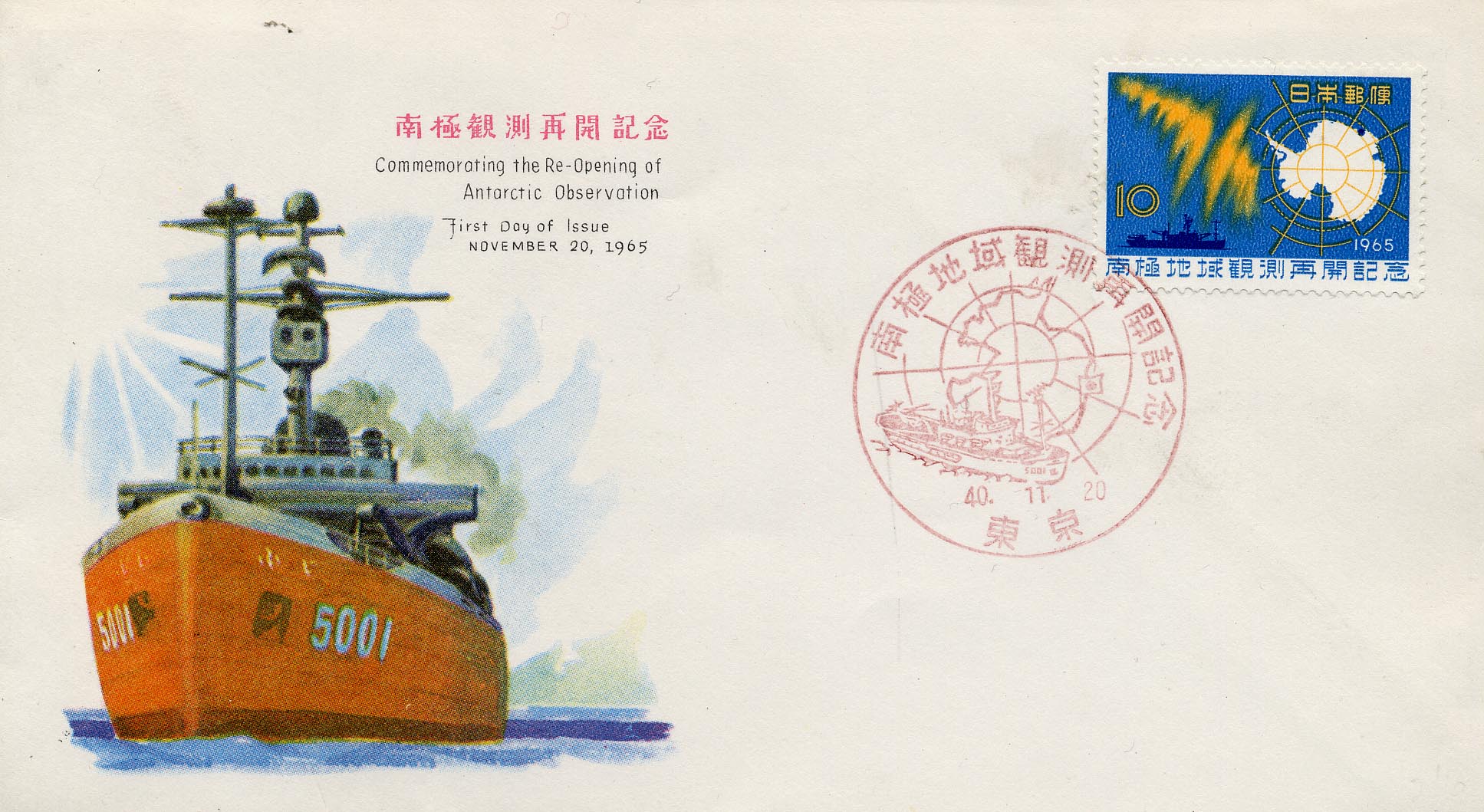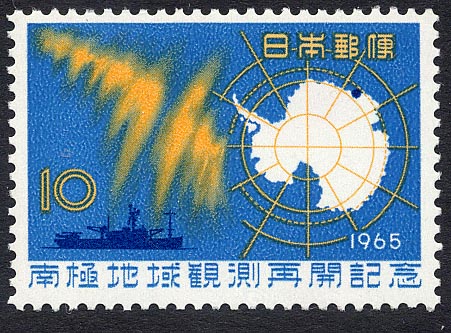

To commemorate the Japanese Antarctic Research Expedition in the Fuji, the first Japanese icebreaker specifically constructed for Antarctic exploration, the Tokyo Post Office issued a special stamp and a special envelope, both showing the vessel, when the Fuji made her maiden voyage. Previously Japanese Antarctic expeditions were made in the Soya, a ship converted for research duties and chartered by the Japanese National Committee for the International Geophysical year in 1957. The Soya appeared on a Japanese stamp issued in 1957 in connection with the International Geophysical Year.
Experience gained from the Antarctic explorations made by the Soya, which had a very rough time during her two voyages, was taken into account in the designing of the Fuji, built by the Tsurumi shipyard of the Nippon Kokan Kaisha for the Japanese Defence Agency. Her builders claim that she is "unquestionably the world's most modern observation ship, equipped for conducting 11 types of observations - meteorology, upper meteorology, ionosphere, cosmic rays, aurora, oceanography, biology, topography, terrestial magnetism, earthquakes and gravity".
The Soya twice became fast in the ice: on the first occasion the American icebreaker U.S.S. Burton Island released her and the second time she was freed by the Russian ice breaker Ob (shown on different Russian stamps). To enable the Fuji to avoid being caught in ice packs in the polar regions the new ship has maximum icebreaking devices. Heeling and trimming tanks are incorporated in the hull, together with additional anti-rolling tanks. Powerful pumps can transfer 4,500 tons of water per hour from one part of the ship to another, as required, either for heeling or trimming, enabling the ship to roll and dip on the ice pack, crushing it.
Like all modern icebreakers the Fuji has a wide beam in comparison to her length. Her dimensions are: length 328 ft. (o.a.), beam 69 ft., draft 26.5 ft. and displacement fully loaded 8,566 tons (normal displacement 7,760 tons). She has a crew of 182 and carries a 40-man scientific party. Her bows are specially designed for icebreaking, inclining at an angle of 30 deg. above the waterline and stepping back to 45 deg. below it. Both propellers, which are of stainless steel, and the rudder are protected against ice by specially constructed guards, and the vessel has a maximum speed of 16 knots (normal 15 knots), with a cruising range of 15,000 miles. Her main machinery can be directly controlled from either bridge or engine room, with three other emergency control positions above deck.
The shipbuilders undoubtedly gave of their best in building the Fuji. They developed a special high-strength steel for her hull, reinforced where needed up to 1.77 ins. in thickness, designed a new system to prevent rolling by special U-shaped tanks which operate whether the vessel is moving or stationary and fitted machinery of remarkable power for the vessel's size. The diesel-electric propulsion plant consists of four Mitsubishi-M.A.N. V8V oil engines, each developing 3,500 b.h.p. at 600 r.p.m., driving four 2,420 Kw generators, providing current for four propulsion motors having an output of 12,000 s.h.p.
amidships and there is a large platform at the after end of the ship for taking off and landing. Immediately abaft the funnel are two of the four heavy-lift cranes, while between them, on top of the hangar is an observation room with a planetarium-type dome above it. A specially strengthened mast is stepped immediately abaft the bridge; near the top is an observation room, while the mast also carries a wide variety of scientific equipment.
SG1017 Sea Breezes 4/66
